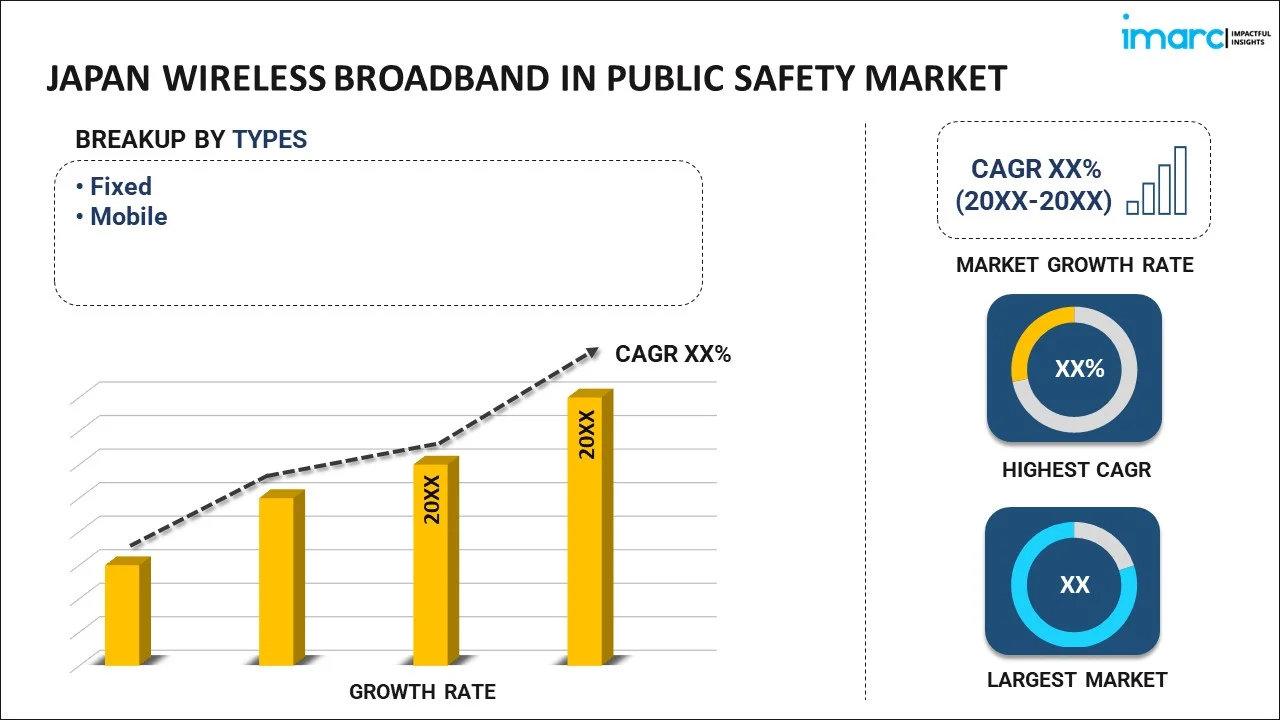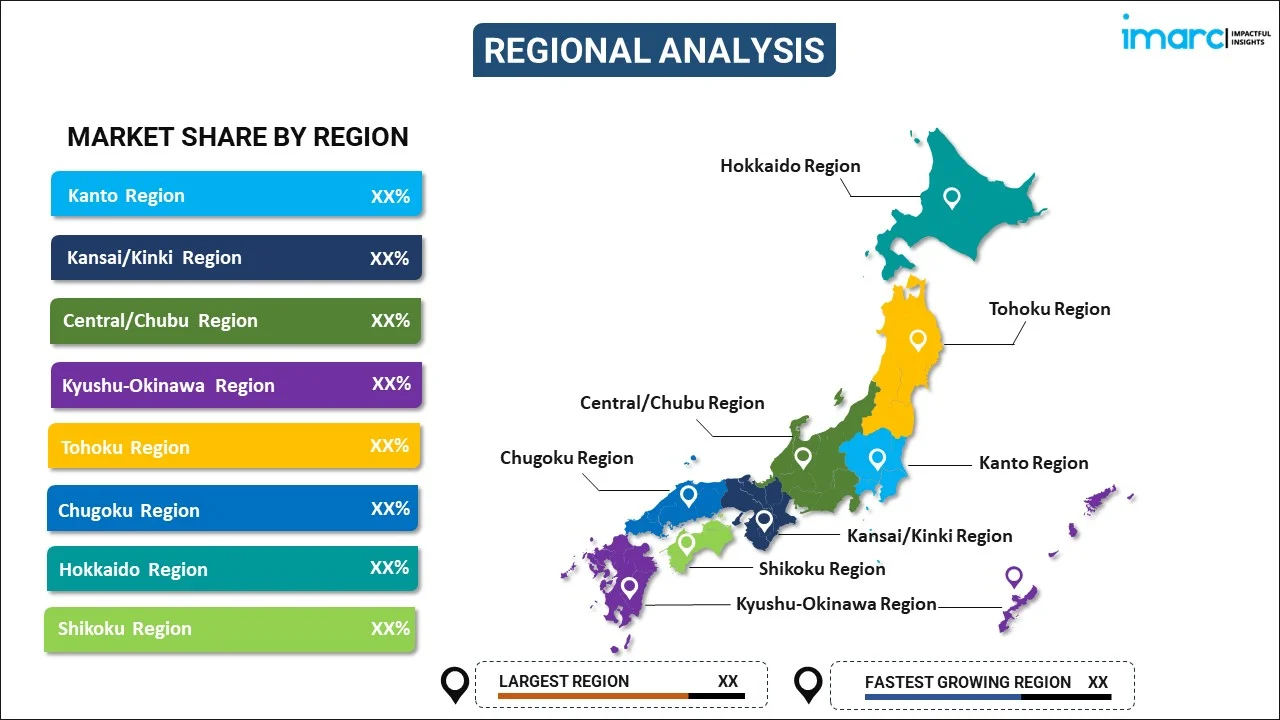
Japan Wireless Broadband in Public Safety Market Report by Type (Fixed, Mobile), Offering (Hardware, Software, Services), Application (Video Surveillance and Monitoring, Automatic Vehicle Tracking, Real-time Incident Management, GIS (Geographic Information System), People Control and Management, and Others). End User (Department of Police, Department of Disaster Management, Medical Emergency Service Providers, and Others), and Region 2025-2033
Market Overview:
Japan wireless broadband in public safety market size is projected to exhibit a growth rate (CAGR) of 21.2% during 2025-2033. The market is being propelled by several key factors, including a growing emphasis on ensuring public safety, an uptick in the occurrences of natural disasters, and notable advancements in wireless communication technology.
|
Report Attribute
|
Key Statistics
|
|---|---|
|
Base Year
|
2024 |
|
Forecast Years
|
2025-2033 |
|
Historical Years
|
2019-2024
|
| Market Growth Rate (2025-2033) | 21.2% |
Wireless broadband for public safety involves the utilization of wireless technology to ensure dependable and secure broadband connectivity for first responders and other personnel involved in public safety efforts. These technological options empower responders to access high-speed data and voice communication services regardless of their location, including remote or disaster-affected areas. The implementation of wireless broadband in public safety facilitates real-time communication and data sharing between field responders and their command centers, thereby enhancing situational awareness and response efficiency. Additionally, it plays a pivotal role in capturing real-time information, supporting functions such as video surveillance, automatic vehicle tracking, real-time incident management, and integrated monitoring of data and devices. Consequently, it has evolved into an indispensable component for contemporary emergency response operations, police patrolling, security measures, and highway control initiatives.
Japan Wireless Broadband in Public Safety Market Trends:
The Japanese market for wireless broadband in public safety is experiencing robust growth, driven by a pressing need for secure and dependable communication networks among first responders and public safety agencies. This demand is amplified by ongoing advancements in mobile connectivity systems and the emergence of cutting-edge communication technologies such as 5G and LTE. Public and private organizations in Japan are increasingly adopting wireless broadband solutions to access real-time information and ensure public safety, shaping a promising market landscape. Furthermore, Japan's vulnerability to natural disasters like earthquakes, hurricanes, and wildfires has heightened the importance of wireless broadband in public safety. These solutions enable effective communication and coordination among responders during emergencies. Simultaneously, the widespread adoption of these solutions to support Global Positioning System (GPS) tracking and location-based services in public safety applications is driving market growth. Apart from this, Japan's strong focus on public safety and the implementation of favorable government policies are additional catalysts for market expansion. Other contributing factors encompass the proliferation of smartphones, laptops, computers, and IoT devices, the increased penetration of high-speed internet in rural areas, and the rising use of unmanned aerial vehicles (UAVs) for public safety applications, all of which will present lucrative growth prospects for the market in Japan over the forecasted period.
Japan Wireless Broadband in Public Safety Market Segmentation:
IMARC Group provides an analysis of the key trends in each segment of the market, along with forecasts at the country level for 2025-2033. Our report has categorized the market based on type, offering, application, and end user.
Type Insights:

- Fixed
- Mobile
The report has provided a detailed breakup and analysis of the market based on the type. This includes fixed and mobile.
Offering Insights:
- Hardware
- Software
- Services
A detailed breakup and analysis of the market based on the offering have also been provided in the report. This includes hardware, software, and services.
Application Insights:
- Video Surveillance and Monitoring
- Automatic Vehicle Tracking
- Real-time Incident Management
- GIS (Geographic Information System)
- People Control and Management
- Others
The report has provided a detailed breakup and analysis of the market based on the application. This includes video surveillance and monitoring, automatic vehicle tracking, real-time incident management, GIS (geographic information system), people control and management, and others.
End User Insights:
- Department of Police
- Department of Disaster Management
- Medical Emergency Service Providers
- Others
A detailed breakup and analysis of the market based on the end user have also been provided in the report. This includes department of police, department of disaster management, medical emergency service providers, and others.
Regional Insights:

- Kanto Region
- Kansai/Kinki Region
- Central/ Chubu Region
- Kyushu-Okinawa Region
- Tohoku Region
- Chugoku Region
- Hokkaido Region
- Shikoku Region
The report has also provided a comprehensive analysis of all the major regional markets, which include Kanto Region, Kansai/Kinki Region, Central/ Chubu Region, Kyushu-Okinawa Region, Tohoku Region, Chugoku Region, Hokkaido Region, and Shikoku Region.
Competitive Landscape:
The market research report has also provided a comprehensive analysis of the competitive landscape. Competitive analysis such as market structure, key player positioning, top winning strategies, competitive dashboard, and company evaluation quadrant has been covered in the report. Also, detailed profiles of all major companies have been provided.
Japan Wireless Broadband in Public Safety Market Report Coverage:
| Report Features | Details |
|---|---|
| Base Year of the Analysis | 2024 |
| Historical Period | 2019-2024 |
| Forecast Period | 2025-2033 |
| Units | Million USD |
| Scope of the Report | Exploration of Historical Trends and Market Outlook, Industry Catalysts and Challenges, Segment-Wise Historical and Future Market Assessment:
|
| Types Covered | Fixed, Mobile |
| Offerings Covered | Hardware, Software, Services |
| Applications Covered | Video Surveillance and Monitoring, Automatic Vehicle Tracking, Real-time Incident Management, GIS (Geographic Information System), People Control and Management, Others |
| End Users Covered | Department of Police, Department of Disaster Management, Medical Emergency Service Providers, Others |
| Regions Covered | Kanto Region, Kansai/Kinki Region, Central/ Chubu Region, Kyushu-Okinawa Region, Tohoku Region, Chugoku Region, Hokkaido Region, Shikoku Region |
| Customization Scope | 10% Free Customization |
| Post-Sale Analyst Support | 10-12 Weeks |
| Delivery Format | PDF and Excel through Email (We can also provide the editable version of the report in PPT/Word format on special request) |
Key Questions Answered in This Report:
- How has the Japan wireless broadband in public safety market performed so far and how will it perform in the coming years?
- What has been the impact of COVID-19 on the Japan wireless broadband in public safety market?
- What is the breakup of the Japan wireless broadband in public safety market on the basis of type?
- What is the breakup of the Japan wireless broadband in public safety market on the basis of offering?
- What is the breakup of the Japan wireless broadband in public safety market on the basis of application?
- What is the breakup of the Japan wireless broadband in public safety market on the basis of end user?
- What are the various stages in the value chain of the Japan wireless broadband in public safety market?
- What are the key driving factors and challenges in the Japan wireless broadband in public safety?
- What is the structure of the Japan wireless broadband in public safety market and who are the key players?
- What is the degree of competition in the Japan wireless broadband in public safety market?
Key Benefits for Stakeholders:
- IMARC’s industry report offers a comprehensive quantitative analysis of various market segments, historical and current market trends, market forecasts, and dynamics of the Japan wireless broadband in public safety market from 2019-2033.
- The research report provides the latest information on the market drivers, challenges, and opportunities in the Japan wireless broadband in public safety market.
- Porter's five forces analysis assist stakeholders in assessing the impact of new entrants, competitive rivalry, supplier power, buyer power, and the threat of substitution. It helps stakeholders to analyze the level of competition within the Japan wireless broadband in public safety industry and its attractiveness.
- Competitive landscape allows stakeholders to understand their competitive environment and provides an insight into the current positions of key players in the market.
Need more help?
- Speak to our experienced analysts for insights on the current market scenarios.
- Include additional segments and countries to customize the report as per your requirement.
- Gain an unparalleled competitive advantage in your domain by understanding how to utilize the report and positively impacting your operations and revenue.
- For further assistance, please connect with our analysts.
 Inquire Before Buying
Inquire Before Buying
 Speak to an Analyst
Speak to an Analyst
 Request Brochure
Request Brochure
 Request Customization
Request Customization




.webp)




.webp)












